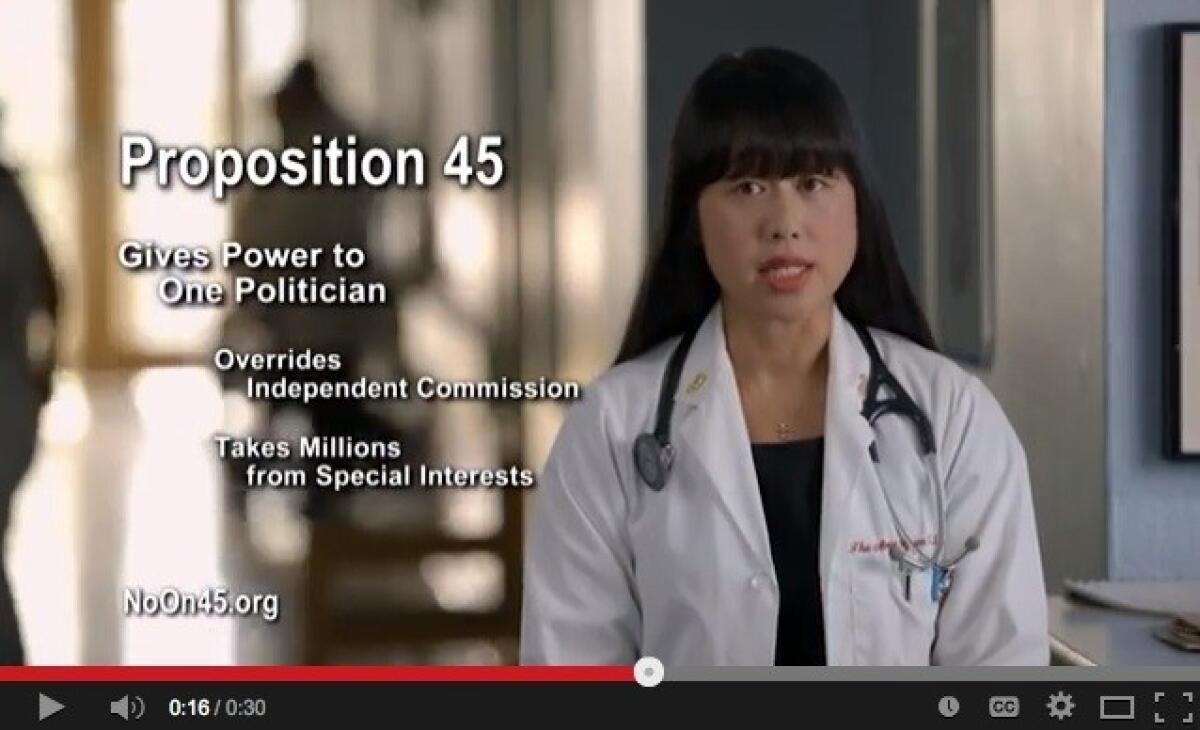Opinion: Sorting through misleading ads for the real Proposition 45

- Share via
Would the real Proposition 45 please stand up?
One of the main arguments advanced by the commercials aired and the torrent of mailers sent by the No on 45 campaign is that the measure would place healthcare in the hands of a single corruptible politician. “Who do you trust with your health care,” a recent mailer asks, “a politician or your doctor? Prop. 45 gives one Sacramento politician control over medical treatment options.”
It’s as if the No on 45 folks were trying to unleash the same “government takeover of healthcare” demon that Republican strategists employed so effectively in the debate over the 2010 Affordable Care Act.
In this case, the attack is misleading, if not flat-out wrong, in at least a couple of significant ways. The first of these is that the measure wouldn’t affect most Californians’ health insurance, let alone their healthcare.
Proposition 45 would expand Proposition 103, the 1988 initiative to toughen the regulation of property and casualty insurance, so that it would apply to individual and small-group health policies. Although the number of people in that category is rising, it still represents well under half of the state’s population.
According to the most recent U.S. Census data, more than 60% of working Californians were employed by businesses with large-group policies. Meanwhile, the Kaiser Family Foundation reports that 33% of all Californians were covered by Medicare, Medi-Cal or some other public plan. None of these people would be affected by Proposition 45.
Nor is it accurate to say that the measure would give the commissioner of insurance control over “medical treatment options.”
The proposition would give the commissioner the power to reject “excessive,” “inadequate” or “unfairly discriminatory” rates for individual and small-group plans before they go into effect. It defines “rates” as “the charges assessed for health insurance or anything that affects the charges associated with health insurance, including, but not limited to, benefits, premiums, base rates, underwriting relativities, discounts, co-payments, coinsurance, deductibles, premium financing, installment fees, and any other out-of-pocket costs of the policyholder.”
Taken in context, the clear meaning of this provision is that the insurance commissioner would be able to consider changes in the value of a policy when judging whether a premium is excessive. If Blue Shield proposed to keep premiums the same on a plan but double the deductible or exclude coverage of knee and hip replacements, that would clearly have some bearing on whether the new rate was excessive.
Nevertheless, the No on 45 campaign somehow contorts that paragraph to mean the insurance commissioner could “make health care decisions,” as Dr. Amy Nguyen Howell warns in a recent mailer. The only decision the insurance commissioner would make is whether a new premium proposed for a plan was excessive, inadequate or unfairly discriminatory in light of what the plan covers.
For the record, The Times’ editorial board opposes Proposition 45 because of the potential interference with Covered California, the state’s new market for individual and small-group policies. For those of us who’ve argued against the measure, watching the No on 45 campaign has been one long exercise in teeth grinding.
The measure’s proponents have hewed more closely to the truth in their (significantly less costly) campaign, focusing on the enormous amount of money that health insurers have poured into No on 45. But they’ve overstated the potential benefit of the measure by arguing that rate regulation will somehow make health insurance affordable.
Here’s one example. “No one should have to pay unaffordable premiums that cover very little,” wrote Margie Keenan of the California Nurses Assn., a backer of Proposition 45, in an op-ed for the Orange County Register.
It’s not hard to find people who’d say that health insurance is already unaffordable, especially for those whose incomes are a little too large for them to qualify for federal subsidies. According to eHealthinsurance.com, the average monthly premium for those not covered by group plans in California is $302 for a single person and $768 for a family.
The Affordable Care Act requires insurance companies to spend at least 80% of their premium revenue on medical care. It does not, however, limit how much doctors, hospitals and other healthcare providers charge private insurers for their services. As easy as it may be to demonize greedy insurers, the main force driving up health premiums has been, and will continue to be, the cost of medical care.
That’s not to say government actuaries shouldn’t be able to cry foul on a proposed premium increase and protect consumers against gouging by health plans that are so dominant in a market, they’re not restrained by competition. I’m just noting that regulating premiums won’t make health insurance affordable. Doing that will take a major overhaul in the way healthcare is delivered and paid for -- a process that the industry and government have started, but aren’t close to completing.
Follow Healey’s intermittent Twitter feed: @jcahealey
More to Read
A cure for the common opinion
Get thought-provoking perspectives with our weekly newsletter.
You may occasionally receive promotional content from the Los Angeles Times.











